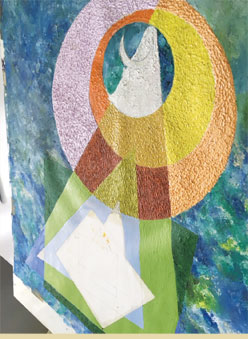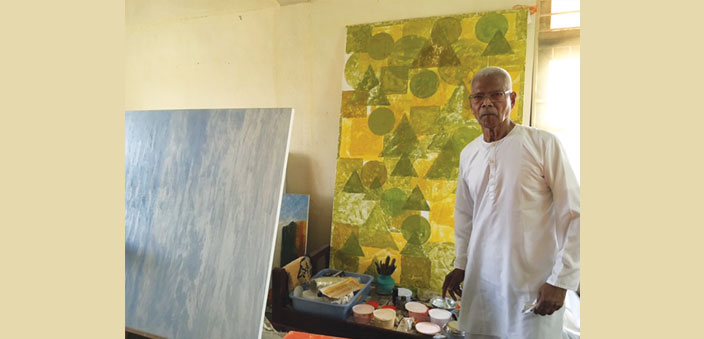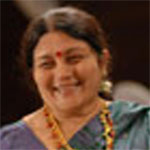Iwant to show the world that age and disability are no barriers for success”, said 82-year-old Vishwanath Ram Kantak, and proved it when he exhibited 40 huge and 40 small paintings done in the evening of his life. Kantak is frail, slightly bent, and is affected by Parkinson’s disease which makes his hands tremble and his gait difficult.
A commercial artist, he wanted to hold a one-man show, and he did it from March 21-27 this year at the prestigious Jehangir Art Gallery in Mumbai. It was also a dream come true, for it was Adi Jehangir, the chairperson of the Gallery himself, who inaugurated it. And people flocked to see his paintings. From far and near, people came, saw and were conquered by the sheer beauty, the colour combinations and the perfection in Kantak’s art.
‘Marvellous,’ said Adi Jehangir who spent over an hour observing all the paintings thoroughly, and even came back a day later to see them again. ‘A true inspiration.’ ‘Enchanting,’ said another art lover. ‘Touching’, ‘mesmerising’, were some of the words used by the viewers on seeing the paintings.
The exhibition was open to the public for seven days, and Kantak sat watching the reactions of the viewers, feeling very pleased and happy, a smile on his face. The exhibition literally took at least a decade years off his age, and he looked younger than he did when he first came to Shantikunj, the senior citizens home run by the Vidhyadhiraj Charitable Trust in Panvel, Navi Mumbai, where he now lives. His apartment at the end of the road is full of colours, painting paper, brushes and other paraphernalia needed for his profession. And he is still painting feverishly, enthused by the success of his first exhibition, planning yet another one in a few months time.
The artist
Born in Goa in 1935, Vishwanath Ram Kantak came to Mumbai and studied at the J J School of Art, and worked as a commercial artist for a few years. He worked in several agencies in Mumbai and Kolkata and was an Art Director. He then chose to be a freelancer, reaching Ramkrishna Mission in the USA, where he lived for a decade before returning to India. Though his son lives in the US and comes to India often, Kantak has chosen to spend his time at Shantikunj in Panvel, where he arrived in 2011.

I met him a year back when someone who saw him painting exclaimed, ‘Kantakji is absolutely normal. Who says he has Parkinson’s disease?’ And I went to see him myself. I marvel at the clarity of the pictures, the detailed thoughtful expressions which bring out the elixir of life. They are neat, clear and confident. For one who has Parkinson’s disease, it is a miracle. He is at his canvasses for as long as it is possible. He tires soon, but his enthusiasm and passion overcome it, and after a brief rest, he is back painting.
His hands shake, his gait is slow, yet when he holds a brush his hands are steady, and there is a spring in his frail legs when he begins his work. Vishwanath Kantak showed me his paints and brushes explaining that he bought the best ones. ‘I bought these beautiful expensive foreign sets which can flourish and create exciting shapes and colours’.
His enthusiasm and hard work, his focus and dedication to his art made him create beautiful paintings which reflect his spiritualism. One can say that he is obsessed by the Trinity of Hindu Gods and sees them everywhere. He sees them in the sky, in the water, on earth, anywhere and everywhere and his feelings, his dreams come alive through these exquisite paintings which express them beautifully. The neatness, the fluidity, the smoothness that symbolises his paintings are some things which one has to see and believe. Even the geometric designs are free hand and perfect.
‘The blue background in my trinity paintings represents the sky. One of the paintings which you can see here represents Brahma, Vishnu and Shiva’, he explains. Neat, well matched colours and shapes represent the holy trinity. Another one represents the essence of Gita. A third one speaks of one of the 36 qualities embedded in all human beings.
He uses crayons, pencils, water colours and even oil colours to produce a perfect combination which is neat and very subtle. Most of his paintings are freehand, but he has also used computerised sketches at times. Kantakji’s dedication is so great that even a few days before the exhibition, he was still ready to produce more till the authorities asked him to put a brake since there was not enough place to display all his creations! The result of his dedicated and continuous hard work, which fuelled his passion and produced such wonderful masterpieces, was in front for the world to see. Besides paintings, he has also created some fabulous artifacts. One of them is a huge falcon which is very attractive and neat. The falcon stands for success, victory and rising above a situation. Egyptians see it as the sign of the rising sun, while Europeans consider the falcon as a warlike symbol and associate it with the Germanic sky God Woden. Falcons are birds of prey which can be trained to hunt other birds and animals and can be seen all over the world except Antarctica. Falcons symbolise superiority, spirit, light, freedom and aspiration. It is also the king of all birds where many gods were shown with the head or body of the Falcon (including Ra). Vishwanath Kantak visualises the falcon as a symbol of rising above a situation. His firm belief that age and disability are no barriers to success is reflected in this beautiful sculpture.
Veena Adige is the Associate Editor of Bhavan’s Journal, the fortnightly magazine of Bharatiya Vidya Bhavan. She has authored four books including The Legacy of Baba Amte. She has written many short and long stories, and freelances for several magazines and newspapers, including Woman’s Era, DNA, and others.


 [/column]
[/column]